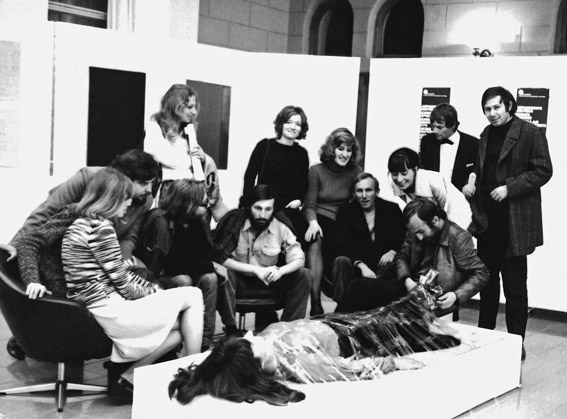The Museum of Contemporary Art Belgrade holds works of the 'six artists'. The six artists – Raša Todosijević, Era Milivojević, Marina Abramović, Zoran Popović, Neša Paripović, Gergelj Urkom – were active in the Student Cultural Centre in Belgrade between 1971, when this institution opened, and 1973. The artists that formed this group had already associated and worked together at the Academy of Fine Arts in the 1960s. Post-socialist art history tends to explain the activities of these artists through the prism of their dissident activities. In this context, their work can be viewed as resistance to the administrative-bureaucratic apparatus that disenabled the free creativity proclaimed by socialist self-management. They opposed the system and way in which art was taught at the Academy, aspiring to establish a contemporary approach to the conceptualisation and work of art institutions. They believed that art must be created in a different way to existing practices of education in the framework of institutions. They can also be defined as a group of individuals linked by the same outlook on life and art. Their position opposed the passive concept of high modernism in art and its aestheticism through the concept of ‘art-life’. This led to the re-evaluation of the concept of the work of art. The artists focused on introducing new forms to art, new media (installations, body art, photography, film, text...). The focus shifted to the artist as subject and his or her voice as author: ‘first-person art’. This was the language of gesture and signs, body language and behaviour... The artists endeavoured to restore the interrupted continuity of the early twentieth-century European avant-garde.
Belgrade’s Student Cultural Centre played an important role in developing cultural education and local and international dialogue through numerous collective projects. The social and political changes of the second half of the 1960s, reflected in the adoption of the new constitution in 1974, marked the developed phase of Yugoslav socialist self-management. This led to greater liberalisation in society and the arts, though the notion of free artistic expression only applied to those themes that were not directed against the ideology of the ruling elite. Nevertheless, artists were no longer obliged to place their work in the service of state and political goals but were able to turn to other topics relating to everyday life in socialism and new art forms. The activities of these six artists in the mid-1970s can also be seen as an alternative to mainstream socialist culture. Although this movement emerged in parallel with developments and ideologies in West European contemporary art, it represented a specific local model within the social system of socialist, self-management Yugoslavia. After 1973, the artists of the Group of Six increasingly began to perform independently of one another. Most would soon leave Yugoslavia and go to live and work abroad.
Since these works mainly belong to the category of new media – photography, film, video, digital media, installations, text, objects – they were acquired by the Museum of Contemporary Art Belgrade after the founding of the Collection in 1977. The works were either purchased from the artists or donated by them. The Museum continues to extend the Collection with further works by these six artists. The most recently obtained work is Era Milivojević’s ’Taping the Artist’ created in 1971 and purchased in 2007. More about the individual pieces and how they became part of the Collection can be found under ‘featured items’.

